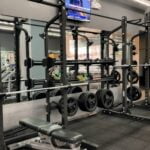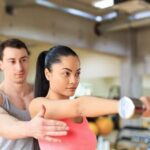Are you looking to learn how to do fitness exercises? Whether you’re new to working out or looking to incorporate new routines into your fitness regimen, understanding the basics and different types of exercises is key to achieving your goals. From cardiovascular exercises to strength training, flexibility, core work, and balance and coordination, this article will cover everything you need to know about how to do fitness exercises effectively.
The importance of fitness cannot be overstated. Not only does regular exercise contribute to a healthy lifestyle, but it also has numerous physical and mental health benefits. Understanding the fundamentals of fitness, such as warm-up and stretching techniques, is crucial in ensuring a safe and effective workout routine. This article will delve into the significance of these basics and provide practical advice on incorporating them into your workouts.
Cardiovascular exercises play a vital role in improving heart health and increasing overall endurance. Running, biking, and swimming are just a few examples of effective cardiovascular activities that can be incorporated into your fitness routine. In addition, strength training through weightlifting and bodyweight exercises is essential for building muscle strength and tone. By understanding each type of exercise, you’ll gain valuable insights on how to structure a well-rounded fitness plan that caters to your individual needs.
Understanding the Basics
Fitness is an essential part of a healthy lifestyle, and engaging in regular exercise has numerous physical and mental benefits. However, before delving into specific exercises, it’s crucial to understand the basics of any fitness routine. This includes warming up the body and incorporating stretching exercises.
The Importance of Warm-Up
Before starting any workout, it’s essential to warm up the body to prepare it for more intense physical activity. A good warm-up increases blood flow to the muscles, loosens the joints, and raises the overall body temperature. This can help prevent injury and improve performance during the workout.
The Role of Stretching
In addition to warming up, stretching is another fundamental aspect of any fitness routine. Stretching helps improve flexibility, range of motion, and posture. It also reduces muscle tension and soreness after a workout. Incorporating both dynamic (movement-based) and static (held) stretches before and after exercising can have a significant impact on overall flexibility and mobility.
Understanding these basic components of exercise sets a solid foundation for a successful fitness journey. By incorporating proper warm-up techniques and effective stretching exercises into your routine, you’ll be better prepared for more intense cardiovascular, strength training, flexibility, core work, balance, and coordination exercises in your workouts.
Cardiovascular Exercises
Cardiovascular exercise is an essential component of any fitness routine. It not only improves heart health but also helps in burning calories, which can aid in weight management. There are various options for cardiovascular exercises, including running, biking, and swimming, each offering its own unique benefits.
Running
Running is a popular form of cardiovascular exercise that requires minimal equipment and can be done almost anywhere. It effectively works the lower body muscles, increases endurance, and can be a great stress-reliever. Whether you prefer outdoor trail running or using a treadmill at the gym, incorporating running into your fitness routine can help improve overall cardiovascular health.
Biking
Cycling is another low-impact cardiovascular exercise that offers great benefits. Whether you choose to ride a stationary bike at the gym or go for outdoor cycling, it provides an effective workout for the lower body and helps in improving stamina. Biking is also a good option for those who may have joint issues as it puts less stress on the joints compared to high-impact activities like running.
Swimming
Swimming is a full-body workout that engages various muscle groups while being easy on the joints. It provides both cardiovascular and strength benefits and can be an excellent option for individuals with injuries or arthritis. Swimming also helps in improving flexibility and coordination due to its range of motion required by different strokes.
Incorporating these cardiovascular exercises into your fitness routine can help improve heart health, increase endurance, and aid in maintaining a healthy weight. Including a variety of these activities can keep your workouts interesting while providing numerous physical benefits.
Strength Training
One of the key advantages of strength training is its ability to increase muscle mass, which in turn helps boost metabolism and burn more calories throughout the day. Additionally, regular strength training can improve bone density, joint flexibility, and overall physical performance. It can also contribute to better posture and reduce the risk of injury in daily activities.
When it comes to weightlifting, beginners should focus on learning proper technique before gradually increasing the amount of weight they lift. Common weightlifting exercises include squats, deadlifts, bench presses, and overhead presses. On the other hand, bodyweight exercises such as push-ups, pull-ups, lunges, and planks can be done anywhere without the need for equipment. These exercises are not only effective for building strength but also for improving balance and coordination.
Incorporating both traditional weightlifting and bodyweight exercises into your fitness routine will help you achieve a balanced approach to strength training. It’s important to start with a manageable level of intensity and gradually progress as your strength improves. Remember to always consult with a fitness professional or trainer if you’re new to strength training to ensure proper form and injury prevention.
Flexibility
Yoga and Pilates are two popular forms of exercise that focus on flexibility, strength, and balance. Both activities offer a wide range of health benefits and can be adapted to any fitness level, making them suitable for everyone. Whether you’re a beginner or an experienced exerciser, integrating yoga and Pilates into your fitness routine can contribute to improved overall physical wellbeing.
Yoga incorporates breathing exercises, meditation, and a series of poses to increase flexibility and muscle strength. It also promotes relaxation and stress reduction. On the other hand, Pilates focuses on building core strength, stability, and flexibility through controlled movements. Both disciplines emphasize proper alignment and form to reduce the risk of injury while enhancing body awareness.
When incorporating flexibility exercises such as yoga and Pilates into your fitness routine, consider the following essential tips:
- Start with a gentle warm-up to prepare your muscles for stretching.
- Focus on proper breathing techniques during each movement.
- Gradually progress to more advanced poses or exercises as your flexibility improves.
By regularly practicing yoga or Pilates, individuals can enhance their range of motion, reduce muscle tension, improve posture, and prevent injuries. Additionally, these activities can aid in stress management and contribute to mental clarity and relaxation. Whether done in a class setting or at home with online tutorials, adding flexibility exercises like yoga and Pilates to your workout regimen can contribute to a well-rounded approach to fitness.
Core Work
The core is an essential aspect of our body’s strength and stability. Developing a strong core is not only beneficial for athletic performance but also for everyday activities and overall posture. Here are some key exercises to help strengthen your core:
- Planks: Planks are an excellent exercise for targeting the entire core, including the rectus abdominis, transverse abdominis, obliques, and lower back muscles. To perform a plank, start in a push-up position with your forearms on the ground, elbows directly beneath your shoulders. Keep your body in a straight line from head to heels, engaging your core and holding the position for as long as possible.
- Russian Twists: This exercise targets the obliques and improves rotational strength. Sit on the floor with your knees bent and feet lifted off the ground. Lean back slightly and clasp your hands together. Twist your torso to one side, then twist to the other side while maintaining balance.
- Leg Raises: Leg raises are effective for targeting the lower abdominal muscles. Lie on your back with legs extended. Keeping your lower back pressed into the floor, lift your legs up towards the ceiling, then slowly lower them back down without letting them touch the ground.
Incorporating these exercises into your fitness routine will help you build a strong and stable core, leading to improved overall strength and performance in various physical activities. Remember to focus on proper form and technique to maximize benefits while minimizing the risk of injury.
Balance and Coordination
The Bosu Ball is a versatile tool that can be used for a variety of exercises to improve balance and stability. Its unstable surface forces your body to engage smaller stabilizing muscles to maintain equilibrium, making it an effective training tool for athletes or individuals looking to enhance their overall physical performance.
Stability Balls, also known as exercise balls or Swiss balls, are another great tool for improving balance and coordination. They can be used for a wide range of exercises that target different muscle groups while simultaneously challenging your ability to stabilize yourself on the ball’s surface. This added challenge can help improve proprioception and core strength.
Trampolines aren’t just for fun – they can also be an effective tool for improving balance and coordination. Rebounding on a trampoline requires constant adjustments in body position to maintain stability, which in turn strengthens the muscles involved in balance. Additionally, trampolines provide a low-impact form of exercise that is easy on the joints while still delivering a high-intensity cardiovascular workout.
| Balance Tools | Benefits |
|---|---|
| Bosu Ball | Targets stabilizing muscles; improves physical performance. |
| Stability Ball | Enhances core strength; challenges muscle stabilization. |
| Trampoline | Improves balance; delivers low-impact cardio workout. |
Putting It All Together
Creating a well-rounded fitness routine is essential to achieve overall physical health and wellness. This involves incorporating a variety of exercises that target different aspects of fitness, including cardiovascular endurance, strength, flexibility, core stability, balance, and coordination. By combining these different elements into a comprehensive workout plan, individuals can maximize the benefits of their exercise regimen.
To create a well-rounded fitness routine, it is important to incorporate a mix of different types of exercises. This may include cardio workouts such as running, biking, or swimming to improve cardiovascular endurance and burn calories. Strength training with weightlifting or bodyweight exercises can help build muscle and increase overall strength.
Flexibility-focused activities like yoga and pilates can improve mobility and reduce the risk of injury. Core work through exercises such as planks, Russian twists, and leg raises can help strengthen the abdominal muscles and improve posture.
In addition to these components, it is also important to include exercises that target balance and coordination. This can be achieved through the use of equipment like Bosu balls, stability balls, or even trampolines. By incorporating these elements into a fitness routine, individuals can ensure that they are addressing all aspects of physical fitness in their workouts.
Bonus Tips
In conclusion, staying motivated and consistent in your fitness journey is crucial for achieving your health and wellness goals. One of the most important things to remember is to set realistic and achievable goals for yourself.
By setting small, attainable milestones, you can track your progress and stay motivated as you work towards your ultimate fitness objectives. Additionally, finding a workout buddy or joining a fitness community can provide you with the support and encouragement you need to keep going, even on tough days.
Another key factor in maintaining motivation and consistency is to mix up your routine and keep things interesting. Trying out new fitness exercises, participating in different types of workouts, or setting challenges for yourself can prevent boredom and plateaus in your progress. Lastly, it’s important to listen to your body and give yourself rest when needed. Overtraining can lead to burnout and injuries, so it’s essential to find a balance between pushing yourself and allowing for proper recovery.
Ultimately, staying motivated and consistent in your fitness journey requires dedication, patience, and a positive mindset. By implementing these bonus tips along with the strategies outlined throughout this article – from understanding the basics of warm-up and stretching to incorporating cardiovascular exercises, strength training, flexibility work, core exercises, balance and coordination drills – you can create a well-rounded fitness routine that will keep you on track towards achieving your health and wellness goals.
Remember that every step forward, no matter how small, contributes to your overall progress – so stay focused, stay determined, and enjoy the incredible benefits of leading an active lifestyle.
Frequently Asked Questions
How Can I Do Fitness Exercises at Home?
You can easily do fitness exercises at home by incorporating bodyweight exercises, such as squats, lunges, push-ups, and planks, into your routine. Additionally, you can use household items like water bottles or chairs to add resistance to your workouts. There are also plenty of online resources and workout videos available that cater to at-home fitness.
How Do You Do Basic Fitness?
Basic fitness can be achieved through a combination of cardiovascular exercises, strength training, and flexibility work. For cardio, activities like brisk walking, running, cycling or dancing can be effective. Strength training can involve using free weights, resistance bands, or simply your own body weight for exercises like squats and push-ups. Don’t forget to incorporate stretching to maintain flexibility.
What Is the Correct Way to Exercise?
The correct way to exercise involves a balance of different types of workouts – including cardiovascular activities (to improve heart health), strength training (to build muscle mass and increase metabolism), and flexibility exercises (to maintain range of motion in the joints). It’s important to start slowly and gradually increase the intensity of your workouts to avoid injury.
Additionally, paying attention to proper form and technique during exercises is crucial for maximizing results while preventing injuries.

Passionate about providing useful information to anyone with an interest in the field of Personal Training, I strive to pass on to our readers quality information and to answer any questions about Personal Trainers, the work they do and how to become one.





